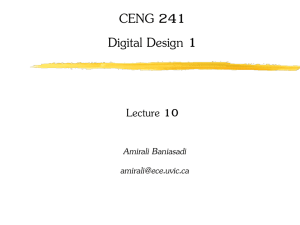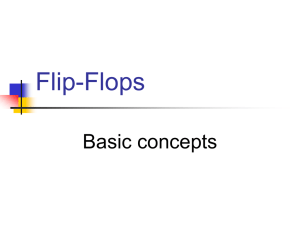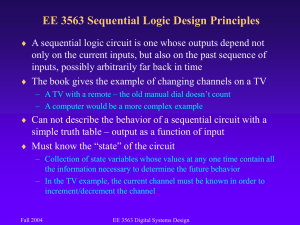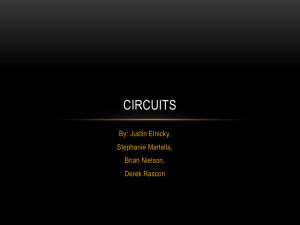Chapter 5 Synchronous Sequential Logic
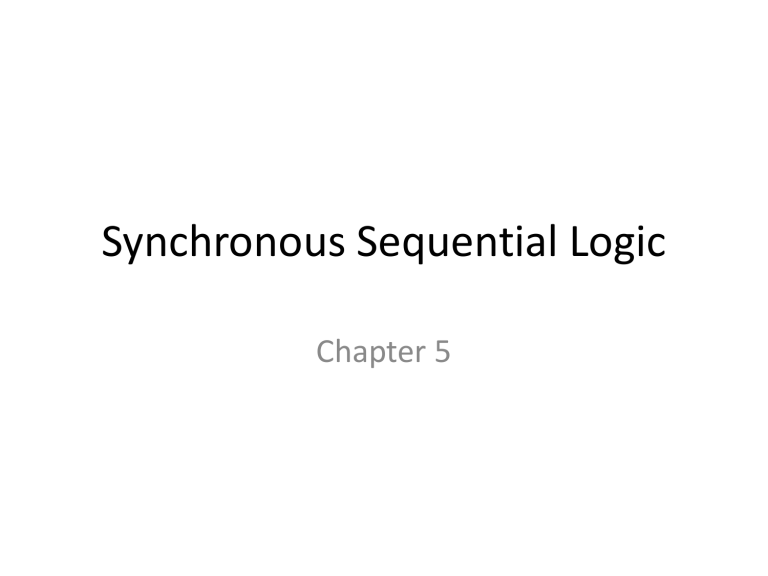
Synchronous Sequential Logic
Chapter 5
Sequential Circuits
• Combinational circuits + storage (store binary information)
• Binary information stored defines the state of the sequential circuit
• External input + present state determine the binary value of outputs and change state in storage elements
Sequential Circuits
Block diagram of a sequential circuit
Sequential Circuits
• Synchronous sequential circuit is a system whose behavior can be defined from the knowledge of its signals at discrete instants of time
• Asynchronous sequential circuit is a system whose behavior depends on the input signals at any instant of time and the order in which the inputs change
Storage elements in synchronous sequential circuits
• Latches: Operate on signal levels
– Level-sensitive devices
• Flip-Flops: Controlled by a clock transition
– Edge-sensitive devices
• Latches are the basic circuits from which all flip-flops are constructed
Sequential Circuits
Synchronous clocked sequential circuit
Storage Elements: Latches
What do you observe in this circuit?
Exercise: Group discussion.
Suppose that Q=1 and Q’=0. What happens with the circuit if S is set to 1 and
R is set to 0?
What happens if S and R are both set to 0?
What happens if S is set to 0 and R is set to 1?
What happens if S and R are both set to 0?
What happens if S and R are both set to 1?
Storage Elements: Latches
Set state
Reset state
SR latch with NOR gates
Storage Elements: Latches
Exercise: Group discussion.
Suppose that Q=1 and Q’=0. What happens with the circuit if S is set to 1 and
R is set to 0?
What happens if S and R are both set to 1?
What happens if S is set to 0 and R is set to 1?
What happens if S and R are both set to 1?
What happens if S and R are both set to 0?
Storage Elements: Latches
Reset state
Set state
SR latch with NAND gates or R’S’ latch
Storage Elements: Latches
Exercise: Group discussion.
Suppose that Q=1 and Q’=0.
What happens with the circuit if S is set to 1, R is set to 0 and 𝐸𝑛 = 0 ?
What happens with the circuit if S is set to 1, R is set to 0 and 𝐸𝑛 = 1 ?
What happens if S is set to 0, R is set to 1 and 𝐸𝑛 = 0 ?
What happens if S is set to 0, R is set to 1 and 𝐸𝑛 = 1 ?
What does 𝐸𝑛 do?
Storage Elements: Latches
SR latch with control input
Storage Elements: Latches
Compare these two latches. What advantage(s) could have one over the other?
D latch (transparent latch)
D latch
Storage Elements: Latches
Graphic symbols for latches
Trigger
Storage Elements: Flip-Flops
Latch
Flip-Flop
Compare the two types of trigger signals.
Clock response in Latch and Flip-Flop
Storage elements: Flip-Flops
Master-slave D flip-flop
Analyze the operation of this circuit. Assume initially Q=0, D=1, Clk=0.
What happens when Clk changes to 1? What happens while Clk remains at 1? What happens when Clk changes to 0?
Other edge-triggered D flip-flop
Discuss with your neighbor classmate the operation of this circuit. Assume some initial conditions.
D-type positive-edge-triggered flip-flop
Edge-triggered D flip-flop
Graphic symbol for edge-triggered D flip-flop
Other flip-flops
JK flip-flop
Let 𝑄 𝑡 be the state of output 𝑄 at time 𝑡 . Analyze what happens to the output at time 𝑡 + 1 for all the different combinations of the 𝐽 and 𝐾 inputs.
Use the table on the following slide.
Table for the analysis of 𝐽𝐾 flip-flop
For the analysis of the 𝐽𝐾 flip-flop fill in the following table.
𝑄(𝑡 + 1)
0
1
𝐽
0
1
1
0
𝐾
0
1
Input function to D flip-flip input: 𝐷 = 𝐽𝑄 ′ + 𝐾 ′ 𝐽
Other flip-flops
T flip-flop (Toggle)
Fill in the following table for the Toggle flip-flop
𝑇
0
1
𝑄(𝑡 + 1)
Characteristic tables
Direct inputs
D flip-flop with asynchronous reset
1
1
Characteristic equations
• Describe logical properties of a flip-flop, just like a characteristic table, e.g.:
•
• For a D flip-flop: 𝑄 𝑡 + 1 = 𝐷
For a JK flip-flop: 𝑄 𝑡 + 1 = 𝐽𝑄 ′ + 𝐾 ′ 𝑄 , and
• For a T-flip-flop: 𝑄 𝑡 + 1 = 𝑇 ⊕ 𝑄 = 𝑇𝑄
𝑇 ′ 𝑄
′ +
Analysis of Clocked Sequential Circuits
• Describes what a circuit will do under certain operating conditions
• Behavior depends on inputs, outputs, and the state of flip-flops
• Outputs are function of inputs and present state
• Analysis obtains a table or diagram for the time sequence of inputs, outputs and internal states, and includes time sequence
State equations
𝐴 𝑡 + 1 = 𝐴 𝑡 𝑥 𝑡 + 𝐵 𝑡 𝑥(𝑡)
𝐵 𝑡 + 1 = 𝐴′ 𝑡 𝑥 𝑡 𝑦 𝑡 = [𝐴 𝑡 + 𝐵 𝑡 ]𝑥′ 𝑡
𝐴 𝑡 + 1 = 𝐴𝑥 + 𝐵𝑥
𝐵 𝑡 + 1 = 𝐴′𝑥 𝑦 = (𝐴 + 𝐵)𝑥′
State table
State table
State table
• Exercise: Compare tables 5.2 and 5.3. What makes the difference?
• Compare any of the state tables (5.2 or 5.3) with the state equations. How do you relate equations and table? How do you obtain one from the other?
𝑥/𝑦
0/0
00
𝐴𝐵
State diagram
0/1
10
1/0
0/1
1/0 0/1 1/0
0
01
1
11
1/0
0 1
Flip-flops input equations or excitation equations 𝑥 𝑦
𝑄
𝐷
𝑄
= 𝑥 + 𝑦
Flip-flops input equations
Input equations
𝐷
𝐴
= 𝐴𝑥 + 𝐵𝑦
𝐷
𝐵
= 𝐴′𝑥
Output equation 𝑦 = (𝐴 + 𝐵)𝑥′
Analysis of circuits with flip-flops
State table has four sections:
Present state Inputs Next state Outputs
Analysis of circuits with flip-flops
• Determine the flip-flop input equations in terms of the present state and input variables
• List the binary values of each input equation
• Use the corresponding flip-flop characteristic table to determine the next-state values in the state table
Analysis with D flip-flops
𝐷
𝐴
= 𝐴 ⊕ 𝑥 ⊕ 𝑦
𝐴(𝑡 + 1) = 𝐴 ⊕ 𝑥 ⊕ 𝑦
Analysis with JK flip-flops
Input equations
𝐽
𝐴
= 𝐵
𝐾
𝐴
= 𝐵𝑥′
𝐽
𝐵
= 𝑥′
𝐾
𝐵
= 𝐴 ⊕ 𝑥 = 𝐴 ′ 𝑥 + 𝐴𝑥′
Analysis with JK flip-flops
𝐴 𝑡 + 1 = 𝐽𝐴
′
+ 𝐾
′
𝐴
𝐵 𝑡 + 1 = 𝐽𝐵′ + 𝐾 ′ 𝐵
Substituting the values of 𝐽
𝐴 and 𝐾
𝐴 for 𝐴 , and 𝐽
𝐵 and 𝐾
𝐵 we obtain:
𝐴 𝑡 + 1 = 𝐵𝐴 ′ + 𝐵𝑥 ′ ′ 𝐴 = 𝐴 ′ 𝐵 + 𝐴𝐵 ′ + 𝐴𝑥
𝐵 𝑡 + 1 = 𝑥 ′ 𝐵 ′ + 𝐴 ⊕ 𝑥 ′ 𝐵 = 𝐵 ′ 𝑥 ′ + 𝐴𝐵𝑥 + 𝐴 ′ 𝐵𝑥′
Analysis with JK flip-flops
Analysis with JK flip-flops
Analysis with T flip-flops
Analysis with T flip-flops
Characteristic equation of T flip-flop
𝑄 𝑡 + 1 = 𝑇 ⊕ 𝑄 = 𝑇
′
𝑄 + 𝑇𝑄′
Input Equations
𝑇
𝐴
= 𝐵𝑥
𝑇
𝐵
= 𝑥
Output Equations 𝑦 = 𝐴𝐵
State Equations
𝐴 𝑡 + 1 = 𝐵𝑥 ′ 𝐴 + 𝐵𝑥 𝐴 ′ = 𝐴𝐵 ′ + 𝐴𝑥 ′ + 𝐴 ′ 𝐵𝑥
𝐵(𝑡 + 1) = 𝑥⨁𝐵
Analysis with T flip-flops
Mealy and Moore models of finite state machines
State Reduction and Assignment
• Analysis of sequential circuit starts with circuit and finishes with state table or diagram
• Design starts with state table or diagram
• State reduction aims at exhibiting the same input-output behavior but with a lower number of internal states
• Fewer internal states leads to fewer flip-flops
• May lead to use more gates
State reduction
An infinite number of input sequences can be applied to a circuit, for example, the one whose state diagram is shown
State a a
Input 0 1
Output 0 0 b
0
0 c
1
0 d
0
0
Algorithm for state reduction
• Two states are said to be equivalent if:
– For each member of the set of inputs they give exactly the same output and send the circuit to either
• The same state or
• An equivalent state
• When two states are equivalent, one of them can be removed
State reduction
Change g by e, which is the equivalent state
Exercise: go through Table 5.6 and try to find equivalent states applying the algorithm described before.
State reduction
State reduction
State reduction
Equivalent state diagrams
State assignment
• Assign a unique code for each state
• For a circuit with 𝑚 states use 𝑛 bits, where
2 𝑛 ≥ 𝑚
• For states remaining use “Don’t care” to help reduce circuit.
State Assignment
What code assignment would you choose? Why?
State Assignment
Draw the state diagram for this assignment.
Design Procedure
1. From the word description and specifications of the desired operation, derive a state diagram for the circuit.
2. Reduce the number of states if necessary
3. Assign binary values to the states
4. Obtain the binary-coded state table
5. Choose the type of flip-flops to be used
6. Derive the simplified flip-flop input equations and output equations
7. Draw the logic diagram
Design Procedure
• Design a circuit that detects a sequence of three or more consecutive 1’s in a string of bits coming through an input line (input is a serial bit string)
0
0
S
0
/0 S
1
/0
0
1
0
1
1
S
1
/0
1
S
1
/0
Synthesis using D flip-flops
𝐴 𝑡 + 1 = 𝐷
𝐴
𝐴, 𝐵, 𝑥 = (3,5,7)
𝐵 𝑡 + 1 = 𝐷
𝐵
𝐴, 𝐵, 𝑥 = (1,5,7) 𝑦( 𝐴, 𝐵, 𝑥 = (6,7)
Synthesis using D f flip-flops
Maps for sequence detector
Exercise: Draw the logic diagram of sequence detector
Synthesis using D flip-flops
Excitation tables
• With D flip-flops design is straightforward
• With JK and T flip-flops input equations must be derived indirectly from the state table
• Need to derive a functional relationship between the state table and the input equations
Excitation tables
Synthesis using JK flip-flops
Question: Why the “Don’t cares”?
Synthesis using JK flip-flops
Synthesis using JK flip-flops
Synthesis using T flip-flops
Design an 𝑛 -bit binary counter.
Use 𝑛 flip-flops
Can count from 0 to 2 𝑛
State diagram of three-bit binary counter
Synthesis using T flip-flops
Discuss with your neighbor classmate this table
Synthesis using T flip-flops
Maps for three-bit counter
Synthesis using T flip-flops
Logic diagram of three-bit counter
• 5.5
• 5.8
• 5.9
• 5.12
• 5.19
Homework assignment
